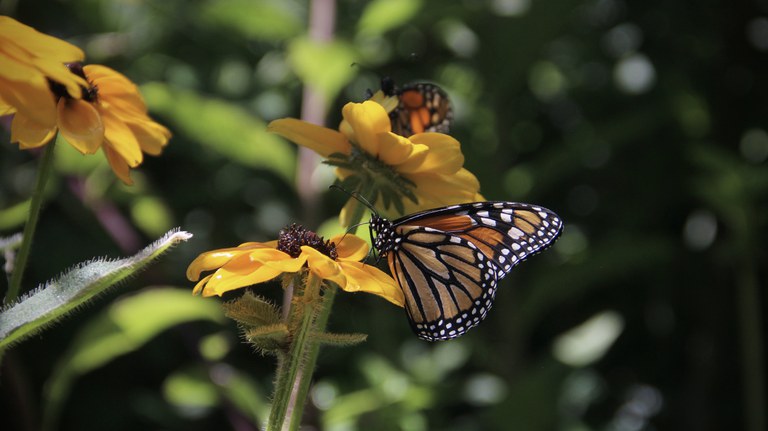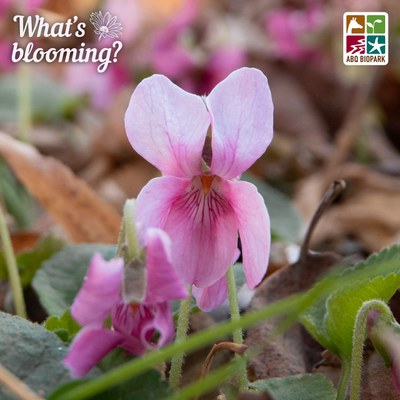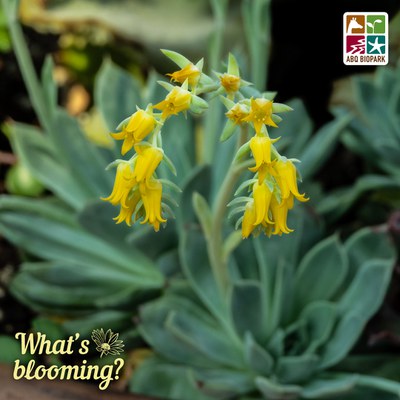Botanic Garden

Opened in 1996, the Botanic Garden has grown to 32 acres of exhibits, and showcases plants from the American Southwest and around the world.
The Botanic Garden’s BUGarium is one of the most elaborate exhibits dedicated to bugs and arthropods in the country.
The Travel Channel cites ABQ BioPark Botanic Garden as one of the top 12 in the country!
Seasonal Update:
Learn more about featured seasonal plants!
Featured on 4/16/25: Dendrobium orchids: A perfect feature for National Orchid Day! This U.S. holiday is celebrated on April 16 each year and recognizes one of the most widespread and diverse flowering plant families, with around 28,000 species in 702 genera. The family Orchidaceae is found in almost every habitat on Earth except glaciers, though the richest concentration is in the tropics. The genus Dendrobium is a very large one, containing over 1,800 species, their cultivars, and hybrids that are native throughout southern and eastern parts of Asia whose roots creep over the surface of trees and rocks instead of in the soil. In addition to their exotic beauty and rainbow of colors, they also play a role in purifying indoor air, removing xylene and toluene from the environment. If that’s not enough, some also boast a sweet fragrance!
This genus is large and complex, so care needs can vary between the 6 distinct groups it’s divided into. All Dendrobium require frost-free conditions and some need warmth and humidity, making them more suited as potted indoor plants here in Albuquerque. Bright, indirect light is best for many varieties as direct sunlight can sunburn the leaves. Watering needs will also vary depending on the flowering season, whether the species needs rest periods, and whether they are evergreen or deciduous, but in general they should not be allowed to dry out completely, nor do you want to drown the roots. Flowers can last anywhere from one day to three months, and each spike can produce between five to twenty flowers over the course of the blooming season. It’s important to know whether the species you’ve chosen is evergreen or deciduous as leaves of deciduous Dendrobiums will yellow and drop, but leafless canes are not dead and shouldn’t be removed. When choosing the flowers that speak to you, make sure to research their individual needs to get the most out of these beautiful additions to your home!
Pictured: Dendrobium Hawaiian Delight ‘Puanani’ in the Mediterranean Conservatory, a hybrid of Dendrobium Micro Chip and Dendrobium Nida

Featured on 4/2/25: The Botanic Garden has welcomed spring with seasonal arrangements located throughout the garden! Look for these classy and colorful containers featuring striking hues of purple, orange or yellow, and white. Herbaceous perennial Viola ‘Penny Blue” makes a beautiful border at around 4-6 inches tall, with a compact habit and subtle fragrance. Standing tall in the middle of the containers at 12-24 inches are the multi-colored ranunculus, cultivars from the genus Ranunculus which contains about 1750 species. The large, thin-petaled flowers resemble roses with their dense layers and are sure to catch your eye, especially when contrasted against the bright white of the ornamental cabbage ‘Osaka Wavy White’. It may not be the first thing many think of, but a bright rosette of frilly white leaves makes ornamental cultivars from the genus Brassica a great choice for a beautiful ground cover that adds dimension and compliments other blooms. Ornamental cabbages can be 12 inches wide and 6 inches tall, so plan your space accordingly when arranging your own borders or containers and look for varieties in other shades as well, including pinks, purples, and reds.
These cool-weather annuals work together perfectly in the spring when the nights are still cool, and can even withstand a light freeze when our New Mexico weather waffles in the transition of the seasons. Full sun to partial shade will yield the best flowering season, ranunculus may not flower at all in full shade. Containers may need more frequent watering than in the ground, but wherever you choose make sure you have good drainage and keep them moist but not soaked. These arrangements will be on display through the beginning of May when summer color will take over, so head in for a spring stroll at the Botanic Garden and check them out!

Featured on 3/26/25: Roses are red, violets are blue; but did you know? They come in pink, too! The sweet, distinctive fragrance is recognized in the species name Viola odorata, with odorata meaning “fragrant” or “perfumed” in Latin. This flowering herbaceous perennial, found around the edges of forests or clearings in parts of Eurasia, is not only popular for its strong scent: both the flowers and leaves are edible and have long been enjoyed fresh, candied, in a syrup, and even in marshmallows! Common names include wood violet, sweet violet, common violet, or March violet for their spring flowering season. V. odorata makes a beautiful, low ground cover in shady areas, leaving a blanket of dark green heart-shaped leaves that are semi-evergreen even after the flowering season.
Violets need a sheltered spot in your garden with dappled sun or shade, and can grow in a variety of fertile soils, as long as they are well-drained. The soil can be allowed to be visibly dry between watering, and then thoroughly saturate them. They can be used in beds, borders, underplanting shrubs and roses, and in containers or pots. They can self-spread by runners at a moderate rate, but can be pruned in late fall. Removing spent flowers may also extend the flowering season, but as the nights warm up above 40º they will go dormant. Whether you choose traditional blues and purples or a variation in pink or white, violets can bring beautiful color and an attractive aroma to your gardens!

Featured on 3/12/25: There’s hardly a better choice for a low maintenance and water-conscious plant in New Mexico than the many species of cactus and succulents. Echeveria is a large genus of flowering succulents, including nearly 200 species and a wide variety of award-winning hybrids, which are native to Central America, Mexico, and northwestern South America in semi-desert habitats. Some species play a vital role as host plants to butterfly species that rely on them for reproduction. Although the foliage of their compact rosettes are evergreen, the flowering season is typically spring and summer when they sprout arching stalks with small, vibrant bell or star-shaped flowers that may be red, orange, yellow, or white which can last for several weeks. Though they will sometimes produce offsets at the base, they are typically slow-growing and stay low to the ground.
Tolerance of drought and full sun are part of what makes species and hybrids of Echeveria a popular ornamental choice for even the most casual gardeners, though they are not frost-hardy and should be brought inside for protection against freezing winters. Some species may also need protection from the hottest sun exposure here, so if you have any doubt about which species or cultivar you have the best bet is an east or southeast-facing light exposure. For the ease of relocation according to temperatures, they are best potted in plants whether you keep yours indoors or outdoors. Water Echeveria and other succulents when the soil is dry, which may be weekly depending on factors such as the container size, sun exposure and heating your home in winter, and how many plants are sharing the same pot. They can benefit from fertilizer and a cactus & succulent soil mix, but should have good drainage. You can also check the plant’s needs by gently feeling the bottom leaves: firm leaves means no additional water is needed, whereas softer leaves are thirsty. Succulents provide an easy, but beautiful, southwestern aesthetic to any space!

No results were found.
